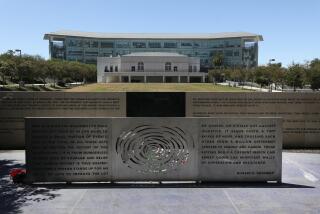Charters get a chance to grow, but how big?
- Share via
A groundbreaking plan to open 51 new Los Angeles schools and 200 existing ones to possible outside control has Randy Palisoc feeling as if salvation is just steps away. A new $54-million campus he covets is rising a block from where his award-winning charter school operates in a rented church.
Palisoc is among many with big dreams since the Los Angeles Board of Education approved its landmark school control resolution last week. The management of about a fourth of all district schools could be up for grabs.
As a result, leading charter school operators anticipate accelerated growth for their organizations and better facilities for some current schools. An 11-school nonprofit group controlled by Mayor Antonio Villaraigosa is eyeing a new high school south of downtown and may bid for more existing campuses. Momentum is building for internal district proposals.
And even the powerful teachers union, which vigorously opposed the plan, is preparing to take part.
School board member Yolie Flores Aguilar, who brought the initiative forward, applauds the results, including the union’s openness to playing a role. “This is precisely the kind of shift that my resolution intended to cause,” she said.
The Los Angeles Unified School District, with 688,000 students, has labored for years to lift student achievement, and the school control plan could become one of the country’s most sweeping education experiments. That’s because the district has so many new schools -- a product of the largest school construction program nationwide -- as well as so many struggling older ones. And within its borders are some of the largest and most sophisticated charter school companies anywhere.
Charter schools are publicly funded but independently managed; they are free of some regulations that govern traditional schools. They also are not required to be unionized.
Under the L.A. Unified plan, charter groups and other outside operators will be able to bid to run the new campuses and about 200 of the district’s poorest-performing schools.
The board allowed its staff 60 days to develop the bidding process, and Supt. Ramon C. Cortines is to make recommendations for individual schools by mid-January. The time frame is short because 21 new campuses will open next year.
The new schools perfectly fit the playbook of charter operator Judy Burton, who heads the 16-campus Alliance for College-Ready Public Schools. Her board requires her to open new schools each year. “Our vision is to be in the communities that need help the most,” Burton said last week. “We will submit proposals.” But Flores Aguilar insists that the 200 low-achieving schools also must be addressed with urgency. These schools, which include elementary and secondary campuses, serve almost exclusively low-income minority students, many with limited English skills. They are spread across the district but are concentrated primarily in higher poverty areas in southern and eastern Los Angeles and the northeast San Fernando Valley.
Palisoc, who runs the 400-student Synergy Academies, said his goal is to help other lower-performing schools match the success of his charter, which needs more space to meet its own goals for growth. For now, at the end of each day, he must pack up books and equipment to make way for Bible studies in the room that doubles as his office and the school’s computer lab. And every Friday, his teachers must dismantle their classrooms too.
“Our school is an in-spite-of school,” Palisoc said. “Schools should be successful because of the system, not in spite of it.”
Those best-positioned to bid for more schools are the large charter management organizations.
But charter operators say their groups lack the capacity to handle anything close to 200 existing schools.
The only such effort so far was the 2008 takeover of Locke High in South Los Angeles by Green Dot Public Schools. Green Dot, for the first time, had to run a neighborhood school that included students with a wide array of disabilities as well as juvenile offenders and foster children, an endeavor that stretched the organization.
The leader of another charter group, ICEF Public Schools, said he could undertake four to seven school turnarounds over the next decade. In addition, ICEF chief executive Michael Piscal said he plans to use the school control resolution as a tool to go after the district’s $233-million downtown arts high school, which will open this month under district management and is not available for outside operators.
Piscal plans first to bid for new schools that will feed students into the arts high school. He’ll also bid for low-performing elementary and middle schools in the area. Rather than pursuing a hostile takeover, he hopes to persuade their faculties to join his organization, arguing that it’s best equipped to develop talent for the arts campus.
With some of these schools operating under his aegis, Piscal said, he could press a claim for the spectacular new facility if its current management foundered.
Another key player is Villaraigosa, who used his influence with the school board to help push through the reform plan.
The mayor’s nonprofit group, the Partnership for Los Angeles Schools, grew out of his unsuccessful 2006 effort to win authority over the entire school district. The partnership started last year with 10 historically low-performing schools, and it hopes to develop a program for kindergarten through high school, said Marshall Tuck, its chief executive.
To pursue that vision, Tuck said, he would need Jordan High in Watts and Clinton Middle School in Historic South-Central L.A., among other campuses. Tuck also has his eyes on a $183-million campus set to open in 2012 to relieve overcrowding at the Santee Education Complex south of downtown, which Villaraigosa’s nonprofit group already manages. So far, many teachers at the mayor’s schools have given the project low marks.
But the mayor’s team did not wait for a formal process to quietly take control of the Mendez Learning Center, a high school opening this fall in Boyle Heights. In an interview, Cortines said that he had opposed the hand-over but that school board President Monica Garcia, a Villaraigosa ally, had insisted on it.
“There was an end-run by the partnership,” the superintendent said. “They found a way to . . . steal the school, and it’s unfortunate.”
Cortines said the new procedures for taking charge of a school would establish rules that neither the mayor nor anyone else could circumvent.
The reform plan will be overseen by newly arrived district official Matt Hill, whose $160,000 salary is paid by the foundation of philanthropist Eli Broad. Hill’s staff expenses are likely to be covered in part by a $4.3-million grant from Los Angeles sports executive Casey Wasserman. Both donors have given money to charter schools, and Broad has said he hopes charters will gradually dismantle L.A. Unified, which he considers beyond hope for rapid improvement.
But L.A. Unified will elevate its game as well, said Cortines, who oversees Hill and the spending of the Wasserman money.
One inside formula would be based on 10 experimental pilot schools in the Pico-Union area.
At these schools, for example, the teachers union has agreed to a process by which ineffective teachers, even tenured ones, can be removed. And principals must receive an annual vote of confidence from a school governing committee.
No entity fought the reform plan harder than United Teachers Los Angeles. Union leaders characterized it as a right wing-inspired privatization scheme that could destabilize public education. They may yet file suit to stop it, but they have also urged teachers to participate.
“If we seize this chance, we could turn this destructive idea into a more promising one,” UTLA President A.J. Duffy said in a bulletin to members. “It could be the mechanism by which we free schools from top-down control.”
--
--
latimes.com/charterbids
Yielding control
An interactive map of more than 250 campuses open to bidding, with links to detailed information on each school.
More to Read
Sign up for Essential California
The most important California stories and recommendations in your inbox every morning.
You may occasionally receive promotional content from the Los Angeles Times.














